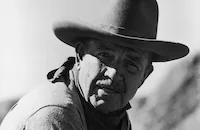Homicide Bureau
Brief Synopsis
Cast & Crew
C. C. Coleman Jr.
Bruce Cabot
Rita Hayworth
Marc Lawrence
Richard Fiske
Moroni Olsen
Film Details
Technical Specs

Synopsis
When his city becomes a haven for criminals, Captain Haines of the Homicide Bureau tells his men they must follow the law, and rejects the advice of Lieutenant Jim Logan to use rough tactics and forget red tape. Jim is ordered to meet a new associate at the airport, scientist J. G. Bliss, who surprises him by turning out to be a woman. Soon after, ex-convict Chuck Brown kills a man in a pool hall, and Jim is sent to investigate. Haines orders a dragnet that results in Chuck's identification, although he has an alibi. Because Chuck's cohorts had replaced the gun and the bullet-cracked window of his car, the police have no evidence on which to hold Chuck, and he is freed. Community leaders complain to the police commissioner that men like Chuck are hounded by police who never believe that an ex-convict will reform. Jim, intuitively knowing that Chuck is guilty, goes to his apartment, and during the ensuing fight Chuck falls from the window and is nearly killed. Despite being reassigned and demoted, Jim continues to investigate and learns that Chuck was involved with a group of racketeers known as the "junk dealer's trade association." R. E. Jamison, an honest junk dealer, learns that Chuck and his cohorts are selling scrap metal to enemy nations, but is killed before he can tell the police. Haines then takes up the case, which leads him to a pier where a ship is being loaded with smuggled guns. Captured by gang leader Ed Briggs, Haines is unaware that Jim is following the two confederates of the mob who murdered Jamison. Jim takes over the engine room, freeing Haines and Blake on the ship. After the police arrive, a gunfight rages until the gang runs out of ammunition. Jim is decorated and his methods are lauded, especially by J. G., whom he will marry.

Director
C. C. Coleman Jr.
Cast

Bruce Cabot

Rita Hayworth
Marc Lawrence
Richard Fiske

Moroni Olsen
Norman Willis
Gene Morgan

Robert Paige
Lee Prather
Eddie Fetherston
Stanley Andrews
Crew

Film Details
Technical Specs

Articles
Homicide Bureau
Homicide Bureau was a routine crime drama programmer starring Bruce Cabot as Lt. Jim Logan, a headstrong cop whose rough interrogation methods cause him to be demoted by his superiors. Despite this, Logan still manages to track down and apprehend a criminal gang who is selling scrap metal to foreign governments that posed a threat to the U.S. Rita Hayworth, who gets second billing, plays a forensics lab technician who is destined to become Logan's wife at the fadeout even though the fifty-six minute feature leaves no time for an on-screen romance to develop between them.
The Irving Briskin unit was known for its fast assembly line precision "and everyone associated with the Briskin unit [according to Gene Ringgold in The Complete Films of Rita Hayworth], directors, players, writers and technicians remained in his good graces as long as they followed his one rule that was not to be violated 'Do it in one take.'"
Hayworth had no illusions about the quality of the movies she was making at this point in her career and later remarked on the Briskin unit films, saying "They were all pretty bad. Did I learn anything from doing them? Yeah, I learned you don't learn much from people who are just interested in getting something done fast instead of right."
The critical reviews for Homicide Bureau mirrored Hayworth's opinion with Weekly Variety reporting that the film "hits new low in cycle of crimewave opuses, with every department of production way below-par for this type of picture."
Homicide Bureau may indeed be nothing more than an undistinguished cop drama but Hayworth, in her unglamorous lab coat amid test tubes and microscopes, was already starting to radiate a certain star quality. Columbia studio head Harry Cohn certainly noticed it and was carefully monitoring her career. After Homicide Bureau, Cohn saw that Hayworth was given a more substantial role in a better film and the result was The Lone Wolf Spy Hunt (1939), a first rate entry in the popular detective series that co-starred her with Warren William and Ida Lupino. The movie marked the first time Hayworth got her own stand-in and instead of having to wear the usual castoffs of the wardrobe department, she was dressed in sleek gowns and expensive furs. It was a sign of better things to come and immediately after The Lone Wolf Spy Hunt Hayworth finally landed her first important film role in Howard Hawks' Only Angels Have Wings (1939) with Cary Grant, Jean Arthur and Richard Barthelmess. By 1940 Hayworth had graduated from supporting roles to leading actress and would never have to make another Homicide Bureau again.
Producer: Jack Frier
Director: Charles C. Coleman
Screenplay: Earle Snell
Cinematography: Benjamin H. Kline
Film Editing: James Sweeney
Art Direction: Lionel Banks
Music: Sidney Cutner
Cast: Bruce Cabot (Jim Logan), Rita Hayworth (J.G. Bliss), Marc Lawrence (Chuck Brown), Richard Fiske (Hank), Moroni Olsen (Captain Raines), Norman Willis (Ed Briggs).
BW-56m.
by Jeff Stafford
SOURCES:
The Life of Rita by Joe Morella & Edward Z. Epstein
www.afi.com
Rita Hayworth: Portrait of a Love Goddess by John Kobal
The Complete Films of Rita Hayworth: The Legend and Career of a Love Goddess by Gene Ringgold

Homicide Bureau
Quotes
Trivia
Notes
Modern sources add the following actors to the cast: John Tyrell (Pool hall attendant); Charles Trowbridge (Henly); George Lloyd (Boat captain); Ann Doran (Nurse); Joseph DeStephani (Miller); Beatrice Curtis (Stewardess); Dick Curtis (Radio broadcaster); Stanley Brown (Police photographer); George De Normand (Trigger); Harry Bernard (Joe); Nell Craig and Georgie Cooper (Committee women); Kit Guard (Mug); Ky Robinson (Casey); Dick Rush (Policeman); Lester Dorr (Gangster): Lee Shumway (Switchboard operator); Wedgewood Nowell (Committee man); Beatrice Blinn and Gene Stone.














